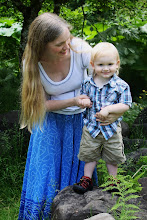I originally saw this idea on
The Imagination Tree, and it's become one of my favorites! Teo was about 2 when we tried it, and he was instantly focused on the fine motor task of painting the tin. I've also done this with kids up to age 5.
To set it up, lay out a large sheet of paper on a tarp. Offer some paint, a brush, and a muffin tin turned upside down. After your child paints the bottom circles, you can demonstrate how to turn it over to make a print. Then your child can try doing it herself (or maybe she will find another way to explore).
Variations
An older child might be interested in using a finger or the end of the paint brush to draw letters or symbols in the paint circles before printing. I'm tempted to do this project myself and write L O V E on the circles and use the finished piece as wrapping paper.
Once you've tried printing with a muffin tin, let your imagination run wild and try other objects for printing. Here are a few suggestions.
- a potato cut in half and carved with a shape / letter / etc (an easy way to do this is to press a metal cookie cutter into the potato and use a knife to cut away the extra)
- a child sized rolling pin or a toilet paper tube with cardboard or foam glued on
- wooden blocks with a raised letter OR legos
- nature items like pine cones, leaves, stones, etc.
- kitchen utensils (potato masher, fork, the rim of a cup, cookie cutters)
- other household items (clothes pin, fly swatter)
- toy animal / doll foot prints
- body parts (hands, feet, elbows, noses)
As you can see, the possibilities are endless.
What are we learning?
Fine Motor Skills, Creative Expression, Early Math (possibly patterning, counting), Sensory, Language / Literacy (if letters are involved, or if you talk about shape names, etc)































